Pimples are inflammatory elements of the skin that appear due to increased activity of the sebaceous glands. Because of this, changes occur not only in the skin, but also in the follicle. Acne can cause infection. Despite the fact that the immune system tries to fight, pus remains under the skin in large quantities. This is very dangerous for your health. Not only teenagers, but also adults are susceptible to acne. As a result, depression and the occurrence of various diseases.
The main causes of acne
Many people ask the question: “What causes acne on the face?” The photos published in this article clearly show how much even a person’s appearance can change, not to mention what happens under the skin. There are many reasons for acne. The most common are hormonal imbalances or changes caused by age. But there are other reasons.
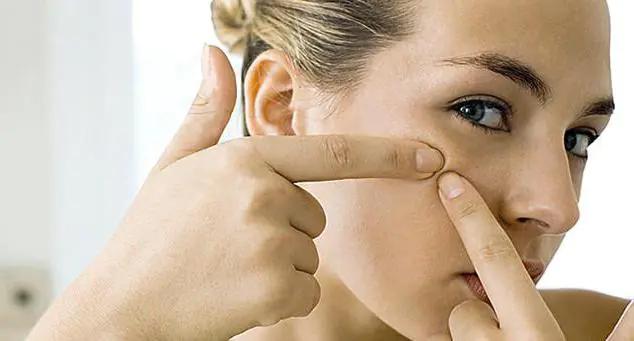
So, let's look at what causes acne on the face:
- excess subcutaneous fat;
- hereditary predisposition;
- poor nutrition;
- stress;
- a lot of dead cells under the skin;
- skin damage;
- inflammation;
- poor facial skin care;
- menstrual cycle;
- lipid metabolism is disturbed;
- the stratum corneum of the skin is enlarged;
- diseases of the stomach and intestines;
- impaired immunity;
- exposure to harmful microorganisms;
- improper use of cosmetics;
- working with toxic substances;
- climate impact;
- excessive cleanliness;
- medicines.
Foods that cause acne
All the reasons listed above are not a complete list of what causes pimples and acne on the face. Sometimes they appear suddenly. Common products that can help with this include:
- Coffee. It should not be drunk on an empty stomach.
- Animal fats. It is better to replace them with vegetable ones.
- Nuts. You should not eat a lot of walnuts, pistachios and almonds.
- Dairy products. It's better to eat low-fat ones. Eat less cheese and ice cream.
- Sweets (candy, sugar, soda, chocolate, etc.).
- Flour products, especially cakes, chips, cookies.
How to choose treatment?
For effective treatment it is necessary to assess the severity of the disease. You can photograph all areas of the skin where pimples, blackheads and blackheads are visible. They determine the degree of the disease. Black dots need to be counted and compared with the scale:
- mild – less than 10 (grade I);
- average – 10-25 (II degree);
- heavy – 26-50 (III degree);
- very severe - over 50 (IV degree).
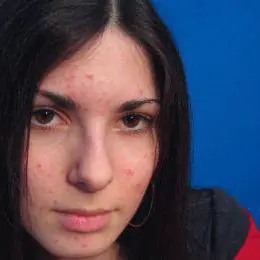
Already formed inflammations (pimples and blackheads) are also calculated in order of increasing degree:
- 1st degree – less than 10;
- 2 tbsp. – 10-20;
- 3 tbsp. – 21-30;
- 4 tbsp. – over 30.
Acne on the face
What causes acne on the face? On the forehead, such inflammations most often form due to the large production of sebum. This area of the face contains many sebaceous and sweat glands. Acne and pimples can appear due to diseases of the gallbladder, pancreas, intestines and stomach.
Inflammatory formations above the eyebrows indicate intestinal irritation. Pimples located closer to the hair indicate a malfunction of the gallbladder. The appearance of acne directly on the forehead means possible intoxication of the body as a whole. Acne on the chin indicates a disorder of the digestive or endocrine system.

Pimples that appear on the nose occur due to hormonal imbalance. This is usually the teenage period. If this phenomenon is observed in an adult, the immune system, digestive or endocrine system may be impaired. pimples on the bridge of the nose are a consequence of liver overload and poor blood purification. Pimples appearing on the lips indicate a violation of the digestive system, and on the cheeks - an overload of the lungs.
Acne in children
Pimples often appear in babies. If they are white, you don't have to worry too much. This is most likely milia (blockage of the sebaceous glands). Such rashes go away on their own after a couple of months. Sometimes acne appears in a child due to allergic reactions. But they can also indicate diseases. Most often, acne in children appears as a result of measles, scarlet fever, rubella, and chickenpox.
Skin problems in adolescence
Acne on the face of a teenager most often appears as a result of puberty, since hormones are responsible for the functioning of the sebaceous glands. During this period, a large amount of secretion is produced. And this is a very favorable environment for the growth of bacteria. As a result of an increase in their numbers, inflammation manifests itself in the form of pimples and blackheads.
It is very difficult to treat them during this period, since the reason lies within the body itself. Please note that everyone's skin is different. This means that treatment is selected strictly individually. But there are some general tips:
- daily facial skin care;
- regular contrast washes twice a day (with hot water and then cold);
- use of facial scrubs;
- use of steam baths.
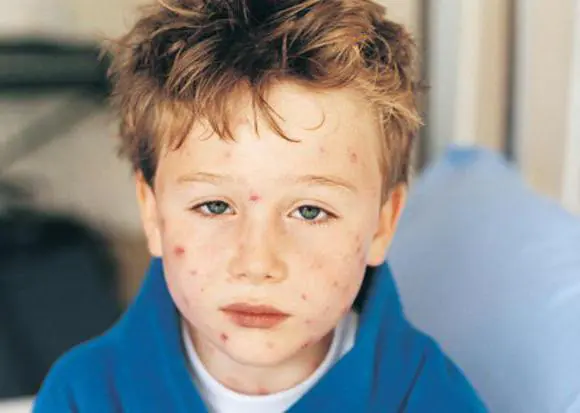
One of the best proven acne treatments is salicylic acid. You can use tar soap and mash. It is prepared in pharmacies according to a doctor's prescription. Apply in the evening with a cotton swab to the face. For external use, brewer's yeast is also good for getting rid of acne. During treatment, you must follow a diet: avoid carbonated drinks, spicy and fatty foods.
Acne in adults
Why do you get acne on your face at 30? Not only teenagers suffer from this problem, but adults can also experience inflammation of the subcutaneous tissues. There are several main reasons why adults also develop acne:
- Hormonal imbalance. In women, this often happens during menstruation or pregnancy.
- Diseases of the gastrointestinal tract.
- Hyperkeratosis (keratinization of the skin). Small “scales” appear. The sebaceous glands work very actively; waste and bacteria accumulate in their mouths. This is where acne and pimples form. This is a very serious and dangerous skin disease that is very life-threatening.
- Demodex mite. One of the most common reasons. Every person has this mite, but it is usually activated when the immune system is weakened. What causes pimples with pus on the face? This is just typical for demodex. Along with inflammation, a general redness of the skin is observed. The disease is treated by a dermatologist. At home, you need to change your bed linen more often.
- Stress.
- Poor hygiene.
- Cosmetical tools.
- Squeezing pimples. After removing one, a dozen new ones may appear.
After squeezing out pimples, wounds remain on the skin, in the treatment of which the cream with a bactericidal and wound-healing effect “ARGOSULFAN ®” has proven itself well. Unlike many antibacterial ointments that have long been familiar to us, to which microbes have developed resistance, it contains silver sulfathiazole, to which bacteria do not become accustomed. The active substance of the cream “ARGOSULFAN ®” has a wide spectrum of antibacterial action and promotes rapid healing of the wound without the formation of a rough scar.
There are contraindications. You need to read the instructions or consult a specialist.
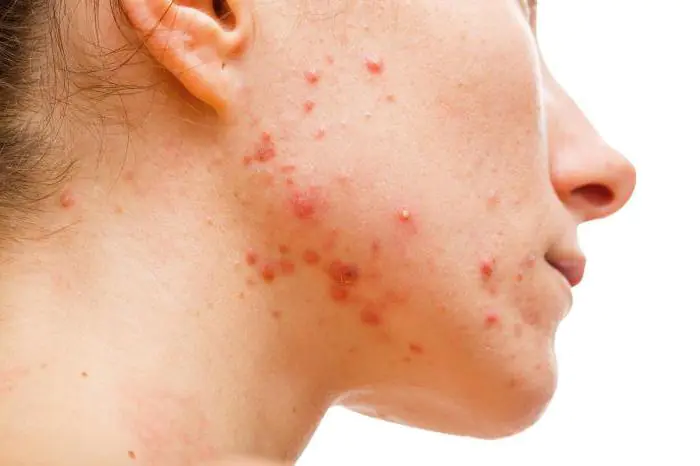
For treatment, it is necessary to correctly determine the cause of acne. But in any case, it is necessary to spend less time in the sun, maintain hygiene and diet, and also take vitamins.
Why do blackheads appear on the face?
What causes pimples and blackheads on the face? Contaminated skin and poor skin care are often to blame for this. Especially if there is no daily cleansing. Poor quality cosmetics are another cause of blackheads and pimples. There are several more reasons:
- deterioration of health;
- hormonal imbalance.
How to destroy acne?
Acne needs to be treated only comprehensively. This includes:
- constant facial cleansing;
- restoration of hormonal levels;
- restorative procedures for the skin;
- fight against pathologies and diseases that cause acne;
- face massage;
- masks;
- medicines;
- hardware therapy methods.
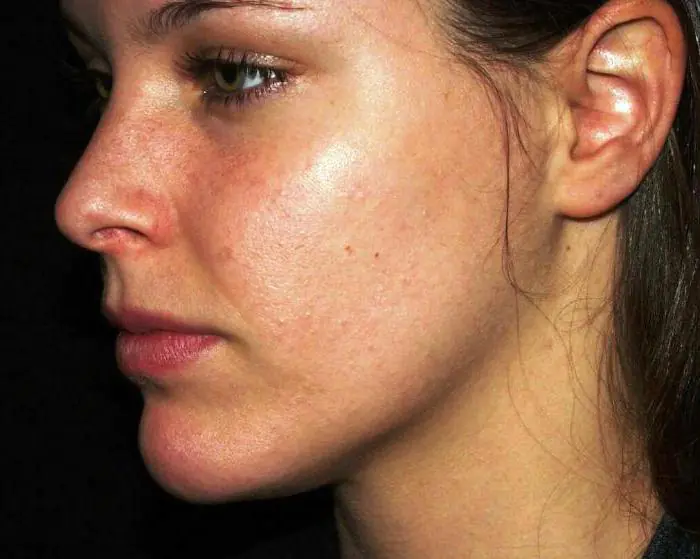
What causes acne on the face? They often occur due to poor nutrition. Therefore, it is even more important to follow a diet during treatment. Especially if you are getting rid of acne. It is necessary to exclude protein-enriched, fatty, spicy and salty foods. As well as chips, carbonated and alcoholic drinks, flavored teas, and sweets. You should give preference to fish, cereals, poultry, vegetables and fruits.
Treatment of acne with green tea
Green tea helps effectively fight acne. It is a good antioxidant and antibacterial agent. Green tea can be used as an herbal supplement or made into a cream. After brewing, the leaves are applied to the face like a mask. But first, the face must be thoroughly cleansed and rinsed with water. In China, to kill acne, green tea is drunk with honeysuckle, but without sugar, as it neutralizes the healing effect.
Treatment of acne with folk remedies
You can try to cure acne on your own. There are folk remedies that people have used since ancient times. All of them are used after preparation in the form of lotions.
- from the leaves of aloe vera;
- calendula with honey;
- from sage leaves.
- St. John's wort;
- from birch buds.
Medicines to treat acne
What causes acne on the face? Whatever the cause of their occurrence, this is subcutaneous inflammation. Since ancient times, acne has been treated with extracts of witch hazel and chamomile. Triclosan, salicylic acid, zinc oxide and vitamins A, B, C help well. When using these drugs, the layer of sebum decreases, as does the process of inflammation in the follicle and skin. All of these drugs have an antibacterial effect. Pharmaceutical products for acne are divided into two groups: for external and internal use.

For external use:
- Retinoids that target the cause of acne. Suppresses the growth of skin cells, prevents and reduces clogging of pores.
- Antibacterial agents act specifically on bacteria. These drugs include antiseptics and antibiotics.
- Azelaic acid agents inhibit cell division. And this ensures the patency of the excretory skin ducts. These drugs have antibacterial properties. Azelaic acid is found in Aknestop cream and Skinoren gel.
How to deal with acne?
After the appearance of rashes on the skin, the question arises: “What causes acne on the face and how to deal with it?” You can try cosmetics, for example:
- Antibacterial soap. But you cannot use it constantly, but only from time to time.
- Cleansing gels regulate the formation of sebum.
- Anti-aging emulsions-creams prevent micro-inflammations.
- Normalizing gels. Antibacterial agents moisturize the skin and remove excess oil.
- Masking pencils. They have an antibacterial effect and dry out acne. Apply at the first stage of inflammation.
- Moisturizing emulsions prevent acne and moisturize the skin.
Device therapy uses several technologies. For example, a complex pulse consisting of a radio frequency range and a light spectrum. When it hits an inflamed area, the impulse affects the cause of acne. There are other technologies.
What causes acne on the face? You need to pay closer attention to your skin. Perhaps the pores are clogged, there are a lot of dead cells, etc. This can be corrected with chemical peeling, which removes a large layer of the epidermis. This uses glycolic and salicylic acid. To combat acne, superficial peeling is also performed. Laser therapy is sometimes used.
To effectively combat acne, it is not enough to know a good dermatologist and acquire an arsenal of special cosmetics. Ideally, it is better to prevent a problem, and to do this you need to be aware of its causes.
- Causes of acne
- Acne map on face
- Determining the severity of the disease
- Preventive measures to combat acne
- Tools Overview
Causes of acne
Not so long ago, recurrent acne on the face received the status of a disease called “acne”, or “acne disease”. The attitude towards them has also become more serious, not just as a local cosmetic defect.
A pimple is an inflammatory element. The process of inflammation is associated with the sebaceous gland. When the outflow of sebum is disrupted for some reason, the ducts of the sebaceous glands become clogged, and acne propionbacteria begin to multiply in them.
To date, several factors have been studied that provoke disruption of the outflow of sebum and inflammation of the sebaceous glands.
Floury, sweet and fatty foods are often the causes of acne © iStock
Poor nutrition
Flour, sweets, and fatty foods are blamed for the appearance of acne - however, these three can be blamed for almost any health problem. Indeed, if you remove these foods from your diet, your skin will become noticeably clearer.
Prevention of rashes includes a healthy, balanced diet and the presence of essential vitamins in the diet. In particular, vitamins A, C, group B. To compensate for the deficiency of useful substances, you can take them in tablets or capsules.
Illiterate care
Oily skin is especially prone to increased activity of the sebaceous glands. That is why she needs products designed specifically for her. Cosmetics for other skin types will not be suitable - they are not able to remove excess fat, if we are talking about cleansing and moisturizing properly (to normalize sebum production).
The ducts of the sebaceous glands become clogged with excess sebum, which mixes with dead epidermal cells, particles of makeup, and everyday pollution. In this regard, when caring for oily skin, special emphasis should be placed on cleansing.
Obviously, touching your face with dirty hands or using unwashed brushes for cosmetics means provoking acne.
Hormonal imbalance
To combat acne, products based on zinc, salicylic acid, and clay are produced. © iStock
And if estrogens (female sex hormones) suppress the production of sebum, then androgens (male hormones), on the contrary, stimulate it. In addition, the point is not so much in the excess of androgens, but in the sensitivity of the sebaceous gland receptors to them. Therefore, with the same hormone levels, one person will have acne and another will not.
Acne in a woman after 20-30 years is a reason to visit a gynecologist and endocrinologist.
Diseases
These are mainly problems with the gastrointestinal tract. If there are problems with digestion (including as a result of poor nutrition), the balance of microflora is disrupted. This also affects the condition of the skin.
Digestive disorders lead to an excess of toxins in the gastrointestinal tract, from where they enter the bloodstream and can negatively affect the condition of the skin, contributing to the occurrence of inflammation.
Emotional condition
For a person with problem skin, stress is a powerful risk factor. The pimple pops up at the most crucial moment, because this moment is associated with emotions and excitement.
“It is known that the stress hormone cortisol provokes increased production of sebum and, as a result, clogged pores,” explains Vichy brand expert Elena Eliseeva.
For the same reason, the connection between deteriorating skin quality and lack of sleep becomes clear. Lack of sleep is also stressful for the body.
Stress and lack of sleep often trigger rashes. Avoid both. © iStock
Climatic factor
Subcutaneous mite
Demodex (subcutaneous mite) is a rather controversial cause of acne. It lives in the skin of 80% of people, but begins to cause trouble, including acne, only against the background of additional health problems or allergies to its waste products.
Acne map on face
Most often, the localization of the rash indicates that it is in this area that the sebaceous gland receptors are very sensitive to the effects of hormones. It is believed that the location of the rash can determine the nature of the problems in the body. In fact, dermatologists do not support this theory, but for general information we will still write about it.
“Favorite” places for acne to appear are the forehead, nose, and chin. © iStock
Part of the so-called T-zone. There are many sweat and sebaceous glands located here, so the skin is often characterized by increased oiliness. It is believed that rashes on the forehead indicate diseases of the large and small intestines.
In adolescence, acne on the cheeks predominates in boys. If acne appears in this area in women, it makes sense to check the hormonal system and intestines.
The nose is also part of the T-zone, where there are many sebaceous and sweat glands.
Here, acne no longer appears in adolescence, but after 30. They are usually associated with hormonal disorders and gynecological problems.
Determining the severity of the disease
The more rashes and inflammations, the more severe the disease. If we are not talking about single pimples, you should consult a dermatologist.
Preventive measures to combat acne
Clear skin for people whose skin is prone to breakouts is the result of careful daily care. It looks something like this.
Cleansing using a special product: it will remove excess sebum, impurities, and makeup.
Washing using gel or foam for oily or problematic skin and toning. Once or twice a week, deep cleansing using clay-based masks is recommended (an approximate scheme for such cleansing is given below).
Hydration – a mandatory step in caring for oily skin. Lack of moisture provokes increased production of sebum. Due to the use of aggressive cleansers, oily skin often becomes dehydrated. It urgently needs moisture to maintain hydrolipid balance. Moisturizing normalizes sebum secretion, which helps fight inflammation and infection.
Camouflage imperfections using foundation, corrector or powder designed specifically for problem skin.
© skin.ru
Tools Overview
Acne prevention program. Cleansing
As a cleansing gel, it cleanses and mattifies the skin. If used as a scrub, it exfoliates and prevents pore clogging. As a mask, it deeply cleanses pores and visually tightens them (apply for 3 minutes, rinse with warm water).
eucalyptus extract, salicylic acid, zinc
Suitable for pre-cleansing before washing: removes makeup, removes impurities.
Completes the cleansing process and tightens pores.
salicylic acid, zinc
Deeply cleanses problematic skin.
two types of mineral clay, thermal water with selenium
Cleanses the skin of excess sebum and impurities, reduces blackheads, pimples and their marks.
charcoal, salicylic acid, blueberry extract
Exfoliates the skin, effectively cleanses pores, prevents the appearance of acne and fights existing ones.
charcoal, salicylic acid, blueberry extract
Pimples constantly appear on the face. What do you advise? I am 21 years old. I use Klerasil cleansing lotion and Baziron medicinal gel. Pimples go away quickly, but new ones appear. I visited a dermatologist and he prescribed me 2 types of lotion. I missed it for more than a month. No effect!
Small red pimples with a white head. And on the cheekbones on both sides they are very huge, under the skin, but they are less noticeable. Very uncomfortable during communication.
I counted about 15 pimples on my face. (((
8 years



